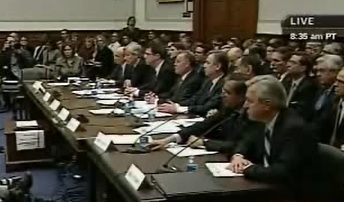By Pam Martens and Russ Martens: April 10, 2019 ~
At 8:00 a.m. yesterday, Politico’s Ben White and Aubree Eliza Weaver dropped the news nugget that the nonprofit watchdog, Better Markets, would be releasing one day ahead of today’s House hearing with the CEOs of the largest banks on Wall Street a report titled: “The RAP Sheet for Wall Street’s Biggest Banks’ Crime Spree,” which promised to detail, for the first time, “that of the more than $29 trillion in total bailouts, the six biggest banks in the country (Bank of America, Citigroup, Goldman Sachs, JPMorgan Chase, Morgan Stanley, and Wells Fargo) received more than $8.2 trillion, or nearly one-third of the total bailouts provided to the entire financial system.”
Wall Street On Parade has been reporting since 2012 that of the secret $16 trillion bailout loans made at almost zero interest rates by the Federal Reserve during the financial crisis, a handful of mega banks on Wall Street received the lion’s share. (See here and here.)
But what Better Markets has done in its new report is to combine the Fed’s largess with that of TARP (Troubled Asset Relief Program) and support provided by the Federal Deposit Insurance Corporation and other guarantee programs. It comes up with the following:
“At least $29 trillion was lent, spent, pledged, committed, loaned, guaranteed, and otherwise used or made available to bailout the financial system during the 2008 financial crash. The American people were told that this unprecedented rescue was necessary because, if the gigantic financial institutions, mostly on Wall Street, failed and went bankrupt (like every other unsuccessful private business in America), then they would take down the entire financial system, which would take down the U.S. economy, wreaking havoc on Main Street families.
“This has actually been true since the 1930s for traditional commercial and retail banks, primarily because they provide essential financial services like checking and savings accounts as well as loans to individuals and businesses small, medium, and large. That is the fuel for the American economy, standard of living, and overall prosperity, which is why those banks are insured by the FDIC and backed by the taxpayers. In addition, those banks were guaranteed because the odds of their failure were minimized—and taxpayers were protected—by numerous banking regulators who policed their activities to promote safe and sound banking practices, making bailouts less likely.
“However, the $29 trillion in bailouts from the Fed, FDIC, and other regulators (in addition to the $700 billion taxpayer dollars made available under the TARP program) were not only or even primarily provided to those regulated banks that take deposits and make loans. Instead, those bailouts were extended to virtually all financial institutions, including those engaging in the most dangerous, high-risk activities that actually caused the financial crash. Thus, for decades gigantic nonbank financial institutions like Goldman Sachs, Morgan Stanley, AIG, money market funds, and many more were allowed to maximize private profits with little or no regulation, but when their activities triggered the crash, they nonetheless were bailed out.
“This was a stunning violation of the most basic rule of capitalism, applicable to virtually every other business in America: Failure leads to bankruptcy.”
Now that the researchers have really gotten readers’ blood boiling about the crony regulators and the secret trillions in bailouts, Better Markets delivers the gut punch. Despite all of that taxpayer support, the mega banks that received it not only continued their crime spree but upped their game. The researchers write:
“In fact, they have engaged in—and continue to engage in—a crime spree that spans the violation of almost every law and rule imaginable. Taking the breadth and depth of their illegal conduct as a whole, the six biggest banks in the country look like criminal enterprises with RAP sheets that would make most career criminals green with envy. That was the case not just before the 2008 crash, but also during and after the crash and their lifesaving bailouts…In fact, the number of cases against the banks has actually increased relative to the pre-crash era.”
Better Markets then proceeds to detail the ghastly RAP sheets of each of the six mega banks. (Read the full report here.)
Against that backdrop, the CEOs of seven of these mega banks will take their seats at a hearing at 9:00 a.m. this morning before the House Financial Services Committee. You can expect to see a lot of their lawyers in the seats behind them.


